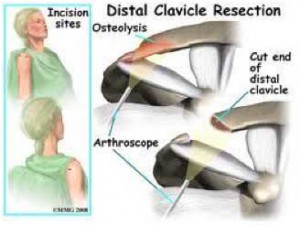Distal Clavicle Excision
(Mumford Procedure)
 Distal Clavicle Excision is a procedure used to treat impingement in the shoulder. Shoulder impingement is a painful condition in which the space between structures in a joint narrows, causing parts to rub or pinch that normally would not, which is very painful for the patient. This procedure treats impingement in the acromioclavicular (AC) joint to return the patient to pain-free mobility. Distal clavicle excision also known as the Mumford Procedure this is a medical operation performed to improve shoulder pain and discomfort by excising the lateral end of the clavical Those suffering from osteoarthritis in the Acromioclavicular joint can opt for this procedure when non-surgical alternatives are unsuccessful The surgery can be performed through open or arthroscopic procedure. A regimen of physical therapy following surgery is prescribed and most patients experience full recovery in 8 to 10 weeks post-surgery.
Distal Clavicle Excision is a procedure used to treat impingement in the shoulder. Shoulder impingement is a painful condition in which the space between structures in a joint narrows, causing parts to rub or pinch that normally would not, which is very painful for the patient. This procedure treats impingement in the acromioclavicular (AC) joint to return the patient to pain-free mobility. Distal clavicle excision also known as the Mumford Procedure this is a medical operation performed to improve shoulder pain and discomfort by excising the lateral end of the clavical Those suffering from osteoarthritis in the Acromioclavicular joint can opt for this procedure when non-surgical alternatives are unsuccessful The surgery can be performed through open or arthroscopic procedure. A regimen of physical therapy following surgery is prescribed and most patients experience full recovery in 8 to 10 weeks post-surgery.
Preparation for Distal Clavicle Excision
- A history, examination and few lab tests
- The surgeon usually orders X-Rays, an MRI, CT Scan, or EMG to look into the joint before the procedure.
- Patient should stop anti-inflammatory drugs like aspirin at least a week before surgery.
- Medications being taken for other conditions like diabetes, heart disease, blood pressure should be continued with advice from the treating doctor.
- History of smoking or alcohol drinking should be told to the surgeon. Smoking should be stopped if possible as it interferes with the wound healing.
- Recent history of cough, cold, fever, viral infections, or other illnesses should be informed to the surgeon.
- Patient is not allowed to eat or drink anything at least 8 to 12 hours before surgery except essential medicines with sips of water.
- Make sure to receive all the equipment needed after going home like a shoulder sling, ice packs or coolers.
Distal Clavicle Excision Surgery
A number of half-inch incisions will be made to allow the arthroscope to enter the shoulder joint. A sterile saline solution will be pumped into the joint both to cleanse it and to expand it for better visualization. The surgical staff may also pump air into the joint to create more room to see inside the joint. While watching a monitor that shows a magnified image of the inside of the shoulder, the surgeon guides the arthroscope to perform a number of procedures within the joint.
After removing any degenerative or damaged tissue around the AC joint and bursa bone spurs from the acromion, or repairing the rotator cuff, the surgeon uses a surgical cutter to remove the last half-inch from the clavicle. The surgeon may then move the arm to test for impingement. The patient may be discharged following the procedure, or may remain in the hospital for one or two days
Recovery from Distal Clavical Excision
- The shoulder is usually covered with dressings and immobilized by a sling. Fingers should be moved to improve the circulation.
- Vitals are monitored by trained nurse for at least half an hour. After this, patient is moved to general ward.
- Patient may be discharged on the same day or may have to be admitted overnight. Pain relieving medications are given to the patient.
- Shoulder sling is usually advised to use for about three to six weeks. Follow-up
- Swelling should be monitored and sling should be used strictly for 2 days after surgery. The ice packs should be applied three or four times a day.
- Some drainage of blood or fluid can occur during first 2 days.
- Sling should be used continuously for first few days. But, intermittent use of the sling may need to be continued for three to six weeks.
- Bathing to be started after 7 days of the surgery.
Distal Clavicle Excision Complications/Risks:
- Blood clots (very rare)
- Surgical wound infection
- Reaction to anesthesia
- Risk of developing arthritis
- Weakening of muscles
- Stiffness
- Neurovascular injury
